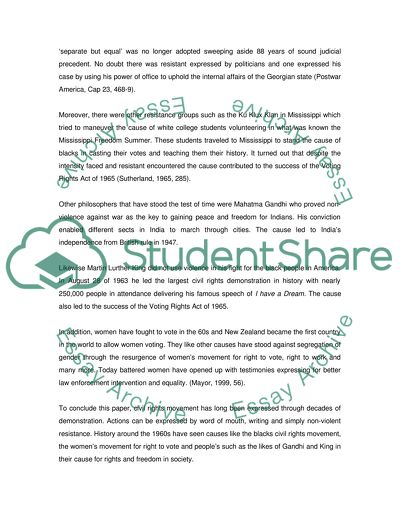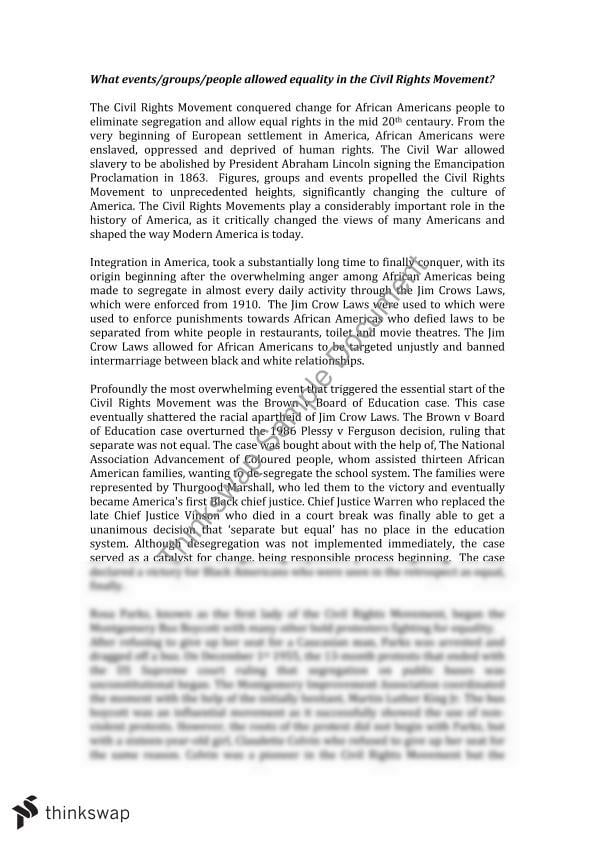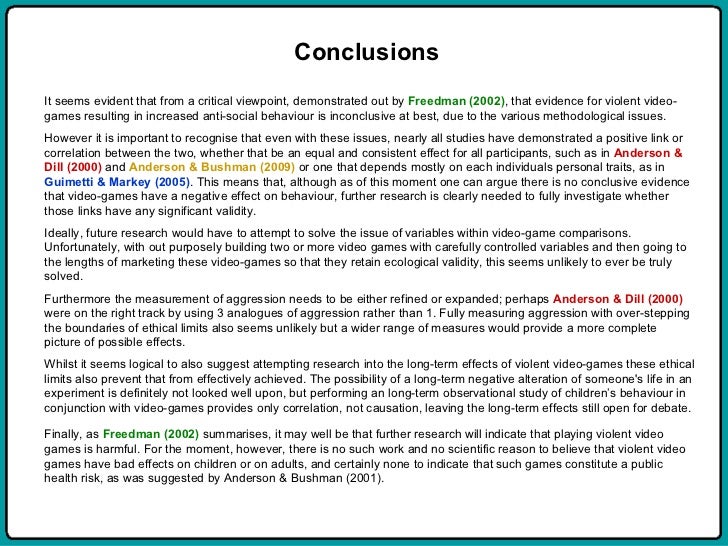
Jun 22, · Life in Hiding: Myanmar’s Civil Disobedience Movement By Robert Bociaga Despite dwindling funds and constant fear of arrest, most members of the Civil Rights Act of 18 Stat – Barred discrimination in public accommodations and on public conveyances on land and water. Prohibited exclusion of African Americans from jury duty. Passed by the 43rd Congress (–) as H.R. Civil Rights Act of P.L. 85–; 71 Stat. May 27, · Few books capture the dynamism and energy of what is now called the long civil rights movement better than Lindsey R. Swindall’s The Path to the Greater, Freer, Truer World: Southern Civil
Stokely Carmichael was a U, essays on civil rights movement. While attending Howard University, he joined the Student Nonviolent Coordinating Committee and was jailed for his work with Freedom Riders. Inat the age of 13, Stokely Carmichael became a naturalized American citizen and his family moved to a predominantly Italian and Jewish neighborhood in the Bronx called Morris Park.
Soon Carmichael became the only Black member of a street gang called the Morris Park Dukes. Carmichael was popular among his new classmates; he attended parties frequently and dated white girls.
However, even at that age, he was highly conscious of the racial differences that divided him from his classmates. Being liberal was an intellectual game with these cats. They were still white, and I was Black. Although he had been aware of the American civil rights movement for years, it was not until one night toward the end of high school, when he saw footage of a sit-in on television, that Carmichael felt compelled to join the struggle.
But one night when I saw those young kids on TV, getting back up on the lunch counter stools after being knocked off them, sugar in their eyes, ketchup in their hair—well, something happened to me.
Suddenly I was burning. A stellar student, Carmichael received scholarship offers to a variety of prestigious predominantly white universities after graduating high school in He chose instead to attend the historically Black Howard University in Washingtonessays on civil rights movement, D. There he majored in philosophy, studying the works of Camus, Sartre and Santayana and considering ways to apply their theoretical frameworks to the issues facing the civil rights movement.
At the same time, Carmichael continued to increase his participation in the movement itself. While still a freshman inhe went on his first Freedom Ride—an integrated bus tour through the South to challenge the segregation of interstate travel.
He graduated from Howard University with honors in Carmichael left school at a critical moment in the history of the civil rights movement. Carmichael joined SNCC as a newly minted college graduate, using his eloquence and natural leadership skills to quickly be appointed field organizer for Lowndes County, Alabama.
When Carmichael arrived in Lowndes County inAfrican Americans made up the majority of the population but remained entirely unrepresented in government. In one year, Carmichael managed to raise the number of registered Black voters from 70 to 2, more than the number of registered white voters in the county.
Unsatisfied with the response of either of the major political parties to his registration efforts, Carmichael founded his own essays on civil rights movement, the Lowndes County Freedom Organization.
To satisfy a requirement that all political parties have an official logo, he chose a Black panther, which later provided the inspiration for the Black Panthers a different Black activist organization founded in Oakland, California. At this stage essays on civil rights movement his life, Carmichael adhered to the philosophy of nonviolent resistance espoused by Dr.
Martin Luther King, Jr. In addition to moral opposition to violence, proponents of nonviolent resistance believed that the strategy would win public support for civil rights by drawing a essays on civil rights movement contrast—captured on nightly television—between the peacefulness of the protestors and the brutality of the police and hecklers opposing them.
However, as time went on, Carmichael—like many young activists—became frustrated with the slow pace of progress and with having to endure repeated acts of violence and humiliation at the hands of white police officers without recourse. By the time he was elected national chairman of SNCC in MayCarmichael had largely lost faith in the theory of nonviolent resistance that he—and SNCC—had once held dear.
As chairman, he turned SNCC in a sharply radical direction, making it clear that white members, once actively recruited, were no longer welcome. About 20 miles into Mississippi, Meredith was shot and wounded too severely to continue.
Carmichael decided that SNCC volunteers should carry on the march in his place, essays on civil rights movement, and upon reaching Greenwood, Mississippi on June 16, an enraged Carmichael gave the address for which he would forever be best remembered.
The term also resonated internationally, becoming a slogan of resistance to European imperialism in Africa. It is a call for Black people to define their own goals, to lead their own organizations. Instead, he associated the term with the doctrine of Black separatism, articulated most prominently by Malcolm X.
Unsurprisingly, the turn to Black power proved controversial, essays on civil rights movement fear in many white Americans, even those previously sympathetic to the civil rights movement, and exacerbating fissures within the movement itself between older proponents of nonviolence and younger advocates of separatism. InCarmichael took a transformative journey, traveling outside the United States to visit with revolutionary leaders in Cuba, North Vietnam, China and Guinea.
Upon his return to the United States, he left SNCC and became Prime Minister of the more radical Black Panthers. InCarmichael quit the Black Panthers and left the United States to take up permanent residence in Conakry, essays on civil rights movement, Guinea, where he dedicated his life to the cause of pan-African unity.
Carmichael changed his name to Kwame Toure to honor both the President of Ghana, Kwame Nkrumah, and the President of Guinea, Sekou Toure. InCarmichael married Miriam Makeba, a South African singer. After they divorced, he later married a Guinean doctor named Marlyatou Barry. Although he made frequent trips back to the United States to advocate pan-Africanism as the only true path to liberation for Black people worldwide, Carmichael maintained permanent residence in Guinea for the rest of his life.
An inspired orator, persuasive essayist, effective organizer and expansive thinker, Carmichael stands out as one of the preeminent figures of the American civil rights movement. FACT CHECK: We strive for accuracy and fairness, essays on civil rights movement.
But if you see something that doesn't look right, click here to contact us! Subscribe for fascinating stories connecting the past to the present. The SNCC, or Student Non-Violent Coordinating Committee, was a civil-rights group formed to give younger Black people more of a voice in the civil rights movement.
In the wake of the Greensboro sit-in at a lunch read more. Taking a The civil rights movement was a struggle for social justice that took place mainly during the s and s for Black Americans to gain equal rights under the law in the United States. Malcolm X was an African American leader in the civil rights movement, minister and supporter of Black nationalism. The sit-in movement soon spread Marcus Garvey was a Jamaican-born Black nationalist and leader of the Pan-Africanism movement, which sought to unify and connect people of Essays on civil rights movement descent worldwide.
In the United States, he was a noted civil rights activist who founded the Negro World newspaper, a shipping Frederick Douglass was an escaped slave who became a prominent activist, author and public speaker.
He became a leader in the abolitionist movement, which sought to end the practice of slavery, before and during the Civil War. After that conflict and the Emancipation After gaining her freedom, Truth preached about abolitionism and equal rights for all.
She became known for a speech Live TV. This Day In History. HISTORY Podcasts. History Vault. Shows This Day In History Schedule Topics Stories.
Recommended for you. When the College Football Stars Played NFL Champs. Maginot Line. Stokely Carmichael. Stokely Carmichael on Assassination of Martin Luther King Jr. Carl Stokes on Aiding Cleveland's African-Americans. SIGN UP. RELATED CONTENT. SNCC The SNCC, or Student Non-Violent Coordinating Committee, was a civil-rights group formed to give younger Black people essays on civil rights movement of a voice in the civil rights movement.
Civil Rights Movement The civil rights movement was a struggle for social justice that took place mainly during the s and s for Black Americans to gain equal rights under the law in the United States. Malcolm X Malcolm X was an African American leader in the civil rights movement, minister and supporter of Black nationalism. Marcus Garvey Marcus Garvey was a Jamaican-born Black nationalist and leader of the Pan-Africanism movement, which sought to unify and connect people of African descent worldwide.
Frederick Douglass Frederick Douglass was an escaped slave who became a prominent activist, author and public essays on civil rights movement.
Civil Rights Movement Essay
, time: 13:20
Civil Rights Act of 18 Stat – Barred discrimination in public accommodations and on public conveyances on land and water. Prohibited exclusion of African Americans from jury duty. Passed by the 43rd Congress (–) as H.R. Civil Rights Act of P.L. 85–; 71 Stat. Jun 22, · Life in Hiding: Myanmar’s Civil Disobedience Movement By Robert Bociaga Despite dwindling funds and constant fear of arrest, most members of the Nov 15, · Civil Rights Movement. The civil rights movement was a struggle for social justice that took place mainly during the s and s for Black Americans to gain equal rights

No comments:
Post a Comment